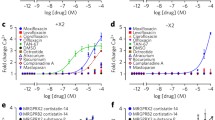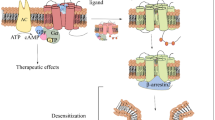Abstract
Based on circular dichroism (CD) and the sequence-predictive method, the opioid-binding cell adhesion molecule (OBCAM) consisted of one half β-sheets and one fourth α-helices. This is consistent with significant sequence homology of the protein to several members of the immunoglobulin (Ig) superfamily, particularly cell adhesion molecules, which are rich in β-sheets. Hydropathy analysis suggests that hydrophobic and hydrophilic regions were evenly distributed along the sequence, but the NH2- and COOH-termini were hydrophobic. Hydrophobic moments and Fourier-transform amphipathic analyses further suggest that residues 23–30 and 83–93 were amphiphathie β-sheets. The overall conformation of OBCAM was unaltered by adding linoleic acid, which is required for opioid ligand binding.
Similar content being viewed by others
References
Chang, C. T., Wu, C.-S. C., and Yang, J. T. (1978).Anal. Biochem. 91, 13–31.
Chen, G. C., and Yang, J. T. (1977).Anal. Lett. 10, 1195–1207.
Cho, T. M., Hasegawa, J., Ge, B. L., and Loh, H. H. (1986).Proc. Natl. Acad. Sci. USA 83, 4138–4142.
Chou, P. Y., and Fasman, G. D. (1978).Ann. Rev. Biochem. 47, 251–276.
Eisenberg, D. (1984).Ann Rev. Biochem. 53, 595–623.
Eisenberg, D., Schwarz, E., Komaromy, M., and Wall, R. (1984).J. Mol. Biol. 179, 125–142.
Eisenberg, D., Weiss, R. M., Terwilliger, T. C., and Wilcox, W. (1982).Faraday Sympos. Chem. Soc. 17, 109–120.
Finer-Moore, J., and Stroud, M. (1984).Proc. Natl. Acad. Sci. USA 81, 155–159.
Garnier, J., Osguthorpe, D. J., and Robson, B. (1978).J. Mol. Biol. 120, 97–120.
Gioannini, T. L., Howard, A. D., Hillier, J. M., and Simon, E. J. (1985).J. Biol. Chem. 260, 15117–15121.
Hasegawa, J., Loh, H. H., and Lee, N. M. (1987).J. Neurochem. 49, 1007–1012.
Heine, H.-G., Francis, G., Lee, K.-S., and Ferenci, T. (1988).J. Bacteriol. 170, 1730–1738.
Kyte, J., and Doolittle, R. F. (1982).J. Mol. Biol. 157, 105–132.
Low, M. G., and Saltiel, A. R. (1988).Science 239, 268–275.
Lowry, O. H., Rosebrough, N. J., Farr, A. L., and Randall, R. J. (1951).J. Biol. Chem. 193, 265–268.
Maneckjee, R., Zukin, R. S., Archer, S., Michael, J., and Osei-Gyimah, P. (1985).Proc. Natl. Acad. Sci. USA 82, 594–598.
Morgan, D. O., Edman, J. C., Standring, D. N., Fried, V. A., Smith, M. C., Roth, R. A., and Rutter, W. J. (1987).Nature 329, 301–307.
Provencher, S. W., and Glockner, J. (1981).Biochemistry 20, 33–37.
Schofield, P. R., McFarland, K. C., Hayflick, J. S., Wilcox, J. N., Cho, T. M., Roy, S., Lee, N. M., Loh, H. H., and Seeburg, P. H. (1989).Embo J. 8, 489–495.
Simonds, W. F., Burke, T. R., Rice, K. C., Jacobson, A. E., and Klee, W. A. (1985).Proc. Natl. Acad. Sci. USA 82, 4774–4978.
Stefano, G. B., Leung, M. K., Zhao, X., and Scharrer, B. (1989).Proc. Natl. Acad. Sci. USA 86, 626–630.
Vogel, H., and Jahnig, F. (1986).J. Mol. Biol. 190, 191–199.
Williams, A. F. (1987).Immunology Today,8, 298–303.
Author information
Authors and Affiliations
Rights and permissions
About this article
Cite this article
Wu, CS.C., Hasegawa, J., Smith, A.P. et al. Opioid-binding protein (OBCAM) is rich in β-sheets. J Protein Chem 9, 3–7 (1990). https://doi.org/10.1007/BF01024977
Received:
Published:
Issue Date:
DOI: https://doi.org/10.1007/BF01024977




